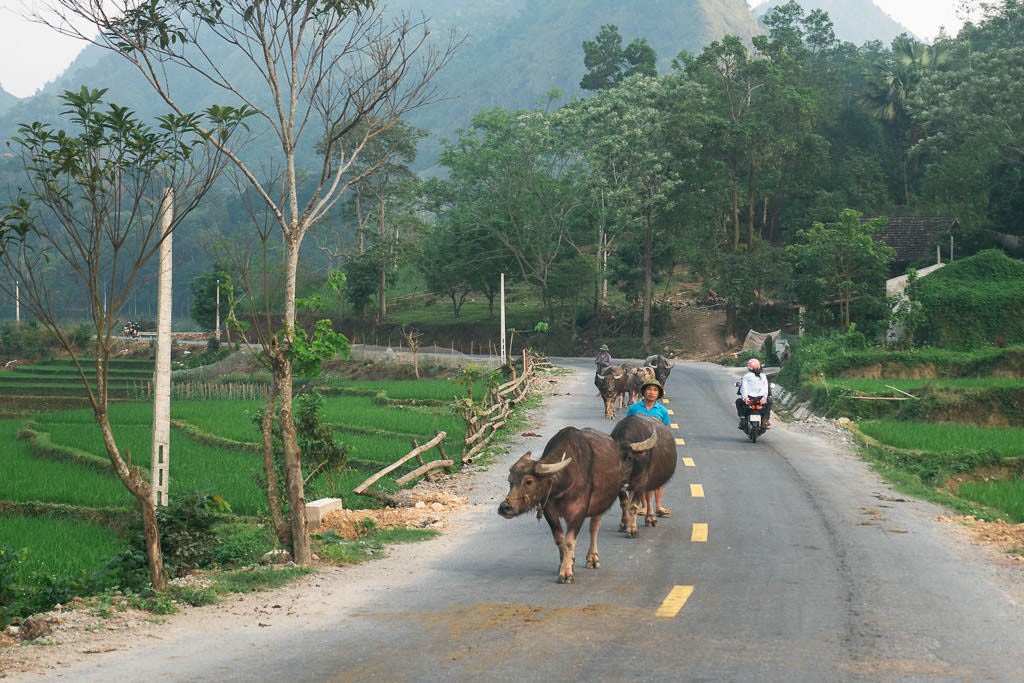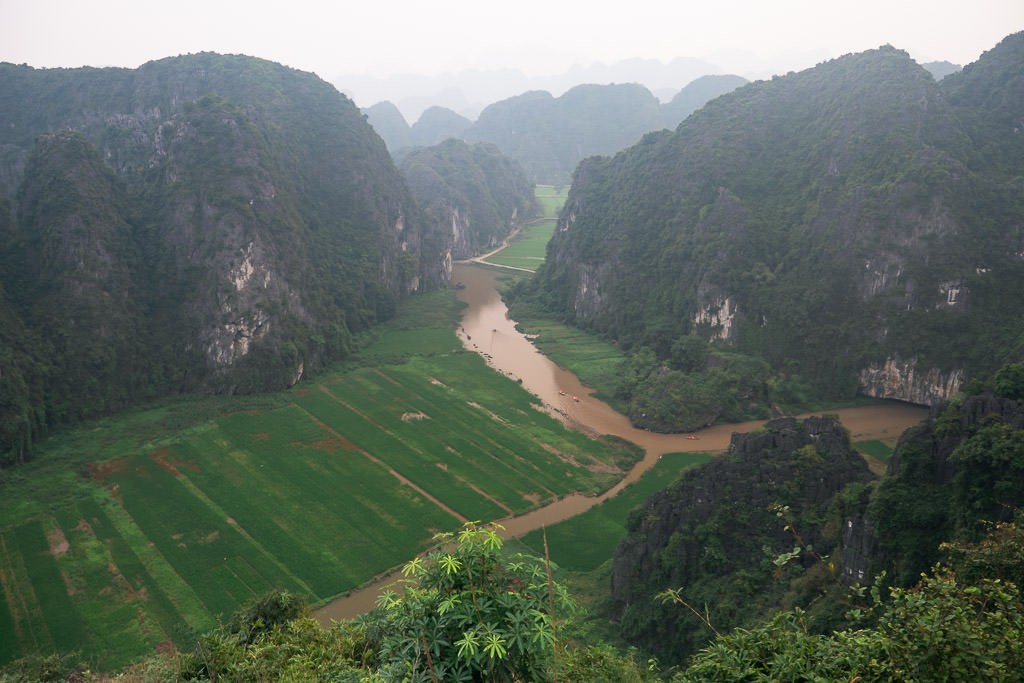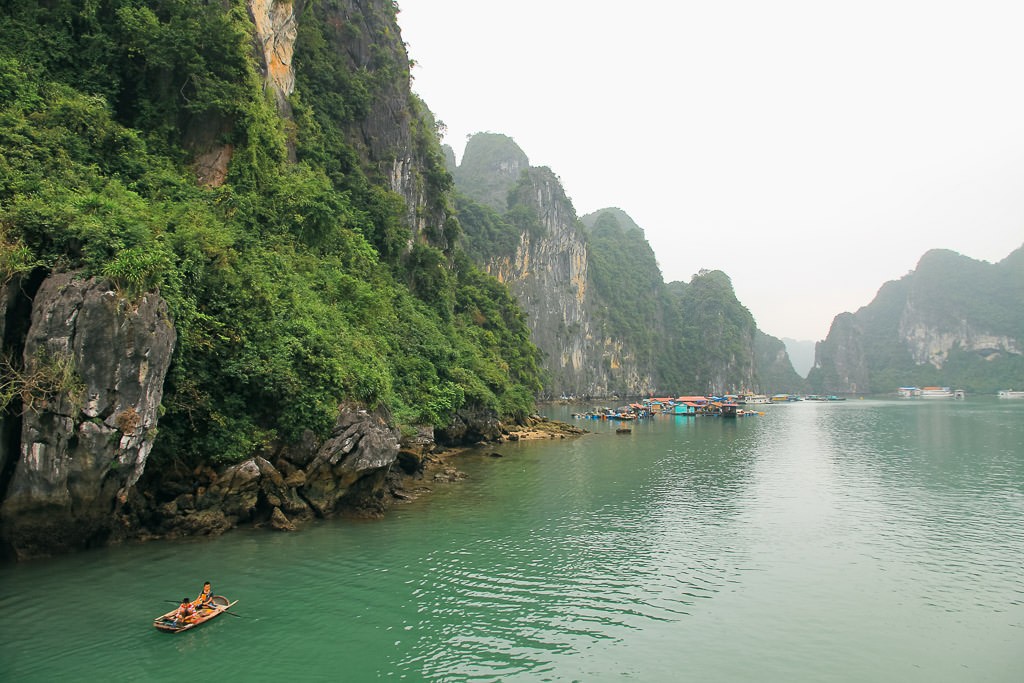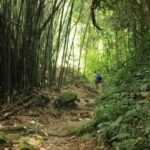Is Vietnam Good Place To Travel? Absolutely! Vietnam offers a captivating blend of vibrant cities, stunning landscapes, delectable cuisine, and rich culture. At TRAVELS.EDU.VN, we’ll guide you through the nuances of this amazing destination, ensuring your trip is unforgettable. Discover the best time to visit, must-see locations, and travel tips for an authentic Vietnamese experience.
1. Understanding the Allure of Vietnam
Vietnam, a land of contrasts, presents a unique travel experience that can be both exhilarating and deeply rewarding. From the bustling streets of Hanoi to the tranquil beauty of Ha Long Bay, this Southeast Asian gem offers something for every traveler. However, it’s crucial to approach Vietnam with the right expectations to fully appreciate its charm. Let’s delve into what makes Vietnam a desirable travel destination and address some common misconceptions.
1.1. A Land of Diverse Landscapes
Vietnam’s geography is incredibly diverse, ranging from the mountainous regions of the north to the fertile Mekong Delta in the south. This variety creates opportunities for different activities, such as trekking, water sports, and cultural experiences. The north boasts stunning rice terraces, while the central coast is known for its pristine beaches. This geographical diversity ensures that no two regions are alike, providing a rich and varied travel experience.
1.2. A Tapestry of Culture
Vietnam’s culture is a blend of ancient traditions and modern influences, shaped by its history and interactions with other countries. The country’s historical sites, such as the ancient town of Hoi An and the Imperial City of Hue, offer glimpses into its imperial past. The local customs and traditions, such as the water puppet shows and traditional music performances, add to the cultural richness of the country. Travelers can immerse themselves in the local culture by visiting temples, attending festivals, and engaging with the local communities.
1.3. A Culinary Paradise
Vietnamese cuisine is celebrated worldwide for its fresh ingredients, bold flavors, and unique cooking techniques. From the iconic pho to the flavorful banh mi, the country’s culinary offerings are as diverse as its landscapes. Food lovers can explore the local markets, sample street food, and take cooking classes to learn the secrets of Vietnamese cuisine. Each region has its own culinary specialties, making the dining experience in Vietnam a journey of discovery.
1.4. Overcoming Common Misconceptions
Like any popular travel destination, Vietnam has its share of misconceptions. One common concern is the potential for scams and tourist traps. While it’s true that such issues exist, they can be minimized by being informed, staying vigilant, and using reputable service providers. Another misconception is that Vietnam is only about beaches and tourist hotspots. In reality, the country offers a wide range of experiences, from exploring remote villages to trekking through national parks. By addressing these misconceptions, travelers can approach Vietnam with realistic expectations and enjoy a more authentic travel experience.
2. What to Expect: The Good and The Not-So-Good
Vietnam, like any travel destination, has its pros and cons. Being aware of these can help you prepare for your trip and manage your expectations. Here’s a balanced view of what to expect.
2.1. The Positives: Why Vietnam Shines
2.1.1. Rich Culture and History
Vietnam’s history is long and complex, with influences from Chinese, French, and American cultures. This blend has created a unique cultural landscape that’s evident in its architecture, cuisine, and customs.
- Historical Sites: Explore ancient cities like Hoi An and Hue.
- Museums: Visit the War Remnants Museum in Ho Chi Minh City for a poignant look at the Vietnam War.
- Temples and Pagodas: Discover spiritual sites like the Perfume Pagoda near Hanoi.
2.1.2. Stunning Natural Beauty
From the rice terraces of Sapa to the caves of Phong Nha, Vietnam’s natural beauty is breathtaking.
- Ha Long Bay: A UNESCO World Heritage site with stunning limestone karsts.
- Sapa: Home to vibrant hill tribes and lush rice terraces.
- Mekong Delta: A maze of rivers, floating markets, and verdant landscapes.
2.1.3. Delicious and Affordable Cuisine
Vietnamese cuisine is world-renowned for its fresh ingredients, vibrant flavors, and affordability.
- Pho: A traditional noodle soup that’s a staple of Vietnamese cuisine.
- Banh Mi: A delicious sandwich with French bread, pate, and various fillings.
- Fresh Spring Rolls: Light and healthy, packed with herbs and vegetables.
2.1.4. Affordable Travel
Vietnam is an excellent destination for budget travelers. Accommodation, food, and transportation are all very affordable compared to Western countries.
- Accommodation: Guesthouses and budget hotels can be found for as little as $15-$30 per night.
- Food: Street food and local restaurants offer meals for just a few dollars.
- Transportation: Buses and trains are inexpensive ways to travel between cities.
2.1.5. Friendly Locals
Vietnamese people are generally very welcoming and friendly, especially towards tourists who show respect for their culture. Learning a few basic Vietnamese phrases can go a long way in making connections.
2.2. The Negatives: Areas for Improvement
2.2.1. Scams and Tourist Traps
Like many popular tourist destinations, Vietnam has its share of scams. Common scams include inflated taxi fares, fake tours, and pickpocketing.
- Taxi Scams: Always use reputable taxi companies like Mai Linh or Vinasun, or use ride-hailing apps like Grab.
- Fake Tours: Book tours through reputable agencies or your hotel to avoid scams.
- Pickpocketing: Be aware of your surroundings, especially in crowded areas.
2.2.2. Pollution and Crowds
Some cities in Vietnam, particularly Hanoi and Ho Chi Minh City, suffer from high levels of air pollution. Tourist hotspots can also be very crowded, especially during peak season.
- Air Pollution: Consider wearing a mask in heavily polluted areas.
- Crowds: Visit popular attractions early in the morning or during the off-season to avoid crowds.
2.2.3. Language Barrier
While English is becoming more widely spoken, many locals, especially outside of tourist areas, may not speak English fluently. Learning a few basic Vietnamese phrases can be helpful.
2.2.4. Infrastructure Challenges
While Vietnam’s infrastructure has improved significantly in recent years, it still faces challenges, especially in rural areas. Roads can be bumpy, and train travel can be slow.
2.2.5. Varying Beach Quality
While Vietnam has a long coastline, not all of its beaches are pristine. Some beaches suffer from pollution or lack the amenities that Western tourists expect. The best beaches are generally found in the south, particularly on Phu Quoc Island.
3. Crafting Your Ideal Vietnam Itinerary
Creating an itinerary that aligns with your interests ensures a memorable and fulfilling trip to Vietnam. Consider these factors.
3.1. Defining Your Travel Style
Before diving into specific destinations, consider your preferred travel style. Are you an adventure seeker, a culture enthusiast, or a relaxation-focused traveler? Do you prefer luxury accommodations or budget-friendly options? Defining your travel style will help you prioritize activities and destinations.
- Adventure Seekers: Focus on trekking, motorbiking, and exploring caves.
- Culture Enthusiasts: Visit historical sites, attend cultural performances, and engage with local communities.
- Relaxation-Focused Travelers: Spend time on the beaches, enjoy spa treatments, and savor local cuisine.
3.2. Must-See Destinations
Vietnam boasts a plethora of attractions. Here are some of the most popular destinations:
- Hanoi: The capital city known for its bustling Old Quarter, historic temples, and delicious street food.
- Ha Long Bay: A UNESCO World Heritage Site featuring stunning limestone karsts rising from emerald waters.
- Hoi An: A charming ancient town with well-preserved architecture, tailor shops, and vibrant night markets.
- Ho Chi Minh City: A dynamic metropolis with a blend of modern skyscrapers and historical landmarks.
- Sapa: A mountainous region with breathtaking rice terraces and vibrant hill tribe cultures.
- Phong Nha-Ke Bang National Park: Home to some of the world’s largest caves and pristine rainforests.
- Da Nang: A coastal city with beautiful beaches, modern bridges, and delicious seafood.
- Mekong Delta: A fertile region with winding waterways, floating markets, and lush orchards.
3.3. Sample Itineraries
To help you get started, here are a few sample itineraries catering to different travel styles:
3.3.1. Classic Vietnam (10 Days)
- Day 1-3: Hanoi – Explore the Old Quarter, visit Hoan Kiem Lake, and enjoy a water puppet show.
- Day 4-5: Ha Long Bay – Take a cruise through the bay, kayak among the karsts, and enjoy onboard meals.
- Day 6-7: Hoi An – Wander through the ancient town, visit tailor shops, and relax on An Bang Beach.
- Day 8-10: Ho Chi Minh City – Explore historical landmarks, visit the War Remnants Museum, and sample street food.
3.3.2. Adventure Vietnam (14 Days)
- Day 1-3: Hanoi – Explore the city and prepare for your adventure.
- Day 4-7: Sapa – Trek through rice terraces, visit hill tribe villages, and enjoy panoramic views.
- Day 8-10: Phong Nha-Ke Bang National Park – Explore caves, hike through rainforests, and kayak on rivers.
- Day 11-12: Hue – Visit the Imperial City, explore the Perfume River, and sample royal cuisine.
- Day 13-14: Da Nang – Relax on the beaches, visit the Marble Mountains, and enjoy seafood.
3.3.3. Relaxation Vietnam (7 Days)
- Day 1-2: Hanoi – Relax and explore the city at your own pace.
- Day 3-7: Phu Quoc Island – Enjoy pristine beaches, swim in crystal-clear waters, and indulge in spa treatments.
3.4. Customizing Your Itinerary with TRAVELS.EDU.VN
At TRAVELS.EDU.VN, we understand that every traveler has unique preferences and interests. That’s why we offer personalized itinerary planning services to help you create the perfect Vietnam experience. Our team of travel experts will work with you to design an itinerary that matches your travel style, budget, and interests. Contact us at +1 (707) 257-5400 or visit our website at TRAVELS.EDU.VN to start planning your dream trip today.
4. Essential Travel Tips for Vietnam
To ensure a smooth and enjoyable trip to Vietnam, here are some essential travel tips:
4.1. Visa and Entry Requirements
Vietnam offers visa exemptions for certain nationalities and e-visas for others. Check the latest visa requirements for your nationality before traveling. As of 2024, many nationalities can obtain a 90-day e-visa online.
4.2. Best Time to Visit
The best time to visit Vietnam depends on the region:
- North Vietnam (Hanoi, Sapa): September to November (dry season, pleasant temperatures).
- Central Vietnam (Da Nang, Hoi An, Hue): February to May (dry season, warm temperatures).
- South Vietnam (Ho Chi Minh City, Mekong Delta): December to April (dry season, hot temperatures).
4.3. Transportation Options
Vietnam offers various transportation options:
- Flights: Domestic flights are a convenient way to travel between major cities.
- Trains: Train travel is scenic but can be slow.
- Buses: Buses are an affordable option but can be crowded.
- Motorbikes: Motorbikes are a popular way to explore the countryside but require a valid license and caution.
- Taxis and Ride-Hailing Apps: Taxis and ride-hailing apps like Grab are readily available in cities.
4.4. Accommodation Choices
Vietnam offers a wide range of accommodation options to suit every budget:
- Guesthouses: Budget-friendly options with basic amenities.
- Hotels: Mid-range options with comfortable rooms and services.
- Boutique Hotels: Stylish hotels with unique designs and personalized service.
- Luxury Resorts: High-end resorts with world-class amenities and stunning locations.
4.5. Health and Safety
- Vaccinations: Consult your doctor about recommended vaccinations for Vietnam.
- Food Safety: Eat at reputable restaurants and street food stalls to avoid food poisoning.
- Water Safety: Drink bottled water and avoid ice in drinks.
- Sun Protection: Use sunscreen, wear a hat, and stay hydrated.
- Mosquito Protection: Use mosquito repellent and wear long sleeves and pants in the evenings to avoid mosquito bites.
4.6. Currency and Payment Methods
The official currency of Vietnam is the Vietnamese Dong (VND). Credit cards are accepted in major hotels and restaurants, but cash is preferred in local markets and smaller establishments. ATMs are widely available in cities.
4.7. Cultural Etiquette
- Dress Code: Dress respectfully when visiting temples and religious sites.
- Shoes: Remove your shoes before entering homes and temples.
- Public Displays of Affection: Avoid excessive public displays of affection.
- Bargaining: Bargaining is common in markets but should be done politely.
- Tipping: Tipping is not customary but is appreciated for good service.
5. Activities and Experiences Not to Miss
Vietnam offers a wealth of activities and experiences. Here are some that should not be missed:
5.1. Exploring Hanoi’s Old Quarter
Wander through the narrow streets of Hanoi’s Old Quarter, sample street food, and soak up the vibrant atmosphere.
5.2. Cruising Ha Long Bay
Take a cruise through Ha Long Bay, kayak among the limestone karsts, and enjoy onboard meals.
5.3. Visiting Hoi An’s Ancient Town
Explore the well-preserved architecture of Hoi An’s Ancient Town, visit tailor shops, and relax on An Bang Beach.
5.4. Discovering Sapa’s Rice Terraces
Trek through the breathtaking rice terraces of Sapa, visit hill tribe villages, and enjoy panoramic views.
5.5. Exploring Phong Nha-Ke Bang National Park
Discover the caves and rainforests of Phong Nha-Ke Bang National Park, and kayak on the rivers.
5.6. Indulging in Vietnamese Cuisine
Sample Vietnamese cuisine, from pho and banh mi to fresh spring rolls and seafood.
5.7. Visiting Ho Chi Minh City’s Historical Sites
Explore the historical sites of Ho Chi Minh City, including the War Remnants Museum and the Reunification Palace.
5.8. Relaxing on Phu Quoc Island’s Beaches
Enjoy the pristine beaches of Phu Quoc Island, swim in crystal-clear waters, and indulge in spa treatments.
6. Overcoming Challenges and Staying Safe
While Vietnam is generally a safe country, travelers should be aware of potential challenges and take precautions.
6.1. Avoiding Scams
- Use reputable taxi companies like Mai Linh or Vinasun, or use ride-hailing apps like Grab.
- Book tours through reputable agencies or your hotel to avoid scams.
- Be aware of your surroundings, especially in crowded areas, to avoid pickpocketing.
- Negotiate prices before purchasing goods or services to avoid overpaying.
- Be cautious of unsolicited offers or overly friendly strangers.
6.2. Staying Healthy
- Consult your doctor about recommended vaccinations for Vietnam.
- Eat at reputable restaurants and street food stalls to avoid food poisoning.
- Drink bottled water and avoid ice in drinks.
- Use sunscreen, wear a hat, and stay hydrated to protect yourself from the sun.
- Use mosquito repellent and wear long sleeves and pants in the evenings to avoid mosquito bites.
6.3. Navigating Traffic
Traffic in Vietnam can be chaotic, especially in cities.
- Be cautious when crossing streets, and use crosswalks when available.
- Consider wearing a helmet if you ride a motorbike.
- Use reputable taxi companies or ride-hailing apps to avoid inflated fares.
- Avoid driving during rush hour if possible.
6.4. Respecting Local Customs
- Dress respectfully when visiting temples and religious sites.
- Remove your shoes before entering homes and temples.
- Avoid excessive public displays of affection.
- Bargain politely when shopping in markets.
- Learn a few basic Vietnamese phrases to show respect for the local culture.
6.5. Staying Connected
- Purchase a local SIM card to stay connected and access the internet.
- Wi-Fi is widely available in hotels, cafes, and restaurants.
- Use a VPN to protect your privacy and security when using public Wi-Fi networks.
7. Reasons to Book Your Vietnam Trip with TRAVELS.EDU.VN
Planning a trip to Vietnam can be overwhelming, especially for first-time visitors. At TRAVELS.EDU.VN, we simplify the planning process and provide you with expert guidance and support.
7.1. Expertise and Experience
Our team of travel experts has extensive knowledge and experience in Vietnam travel. We have personally explored the country and can provide you with insider tips and recommendations.
7.2. Personalized Itinerary Planning
We understand that every traveler has unique preferences and interests. That’s why we offer personalized itinerary planning services to help you create the perfect Vietnam experience.
7.3. Handpicked Accommodations
We have handpicked a selection of accommodations, from budget-friendly guesthouses to luxurious resorts, to suit every budget and preference.
7.4. Reliable Tour Operators
We partner with reliable tour operators to ensure that you have safe and enjoyable experiences throughout your trip.
7.5. 24/7 Support
We provide 24/7 support to assist you with any questions or concerns that may arise during your trip.
7.6. Competitive Pricing
We offer competitive pricing on our tours and services to ensure that you get the best value for your money.
7.7. Customer Satisfaction
Our top priority is customer satisfaction. We strive to provide you with an unforgettable travel experience that exceeds your expectations.
8. Vietnam FAQs
Here are some frequently asked questions about traveling to Vietnam:
- Is Vietnam safe for solo female travelers? Yes, Vietnam is generally safe for solo female travelers. However, it’s important to take precautions, such as avoiding walking alone at night and being aware of your surroundings.
- What is the best way to get around in Vietnam? The best way to get around in Vietnam depends on your budget and preferences. Domestic flights are convenient for long distances, while trains and buses are more affordable options. Motorbikes are a popular way to explore the countryside, but require caution.
- What should I pack for a trip to Vietnam? Pack light, comfortable clothing, sunscreen, mosquito repellent, and a hat. If you plan to visit temples, pack modest clothing that covers your shoulders and knees.
- Do I need to tip in Vietnam? Tipping is not customary in Vietnam, but it is appreciated for good service.
- What is the local currency in Vietnam? The local currency in Vietnam is the Vietnamese Dong (VND).
- Can I use credit cards in Vietnam? Credit cards are accepted in major hotels and restaurants, but cash is preferred in local markets and smaller establishments.
- What is the food like in Vietnam? Vietnamese cuisine is delicious and diverse, with influences from Chinese and French cultures. Popular dishes include pho, banh mi, and fresh spring rolls.
- What are some must-see attractions in Vietnam? Some must-see attractions in Vietnam include Hanoi’s Old Quarter, Ha Long Bay, Hoi An’s Ancient Town, and Sapa’s rice terraces.
- What is the best time to visit Vietnam? The best time to visit Vietnam depends on the region. September to November is best for North Vietnam, February to May for Central Vietnam, and December to April for South Vietnam.
- Do I need a visa to visit Vietnam? Visa requirements vary depending on your nationality. Check the latest visa requirements before traveling.
9. Call to Action: Plan Your Dream Vietnam Trip Today
Is Vietnam good place to travel? Absolutely! With its rich culture, stunning landscapes, and delicious cuisine, Vietnam offers an unforgettable travel experience. At TRAVELS.EDU.VN, we can help you plan your dream trip to Vietnam. Contact us at +1 (707) 257-5400 or visit our website at travels.edu.vn to start planning your adventure today. Our address is 123 Main St, Napa, CA 94559, United States. Let us help you create memories that will last a lifetime.
 Hanoi street scene with vendors
Hanoi street scene with vendors
 Hanoi street scene with vendors
Hanoi street scene with vendors
 View from the top of a mountain in Ha Giang
View from the top of a mountain in Ha Giang
 Rice fields in Sapa under a cloudy sky
Rice fields in Sapa under a cloudy sky
 Tourist boats in Ha Long Bay
Tourist boats in Ha Long Bay

